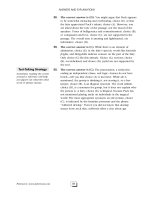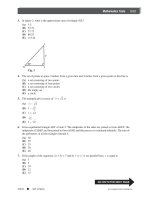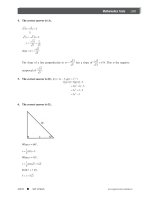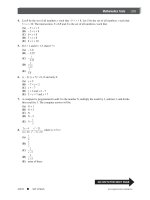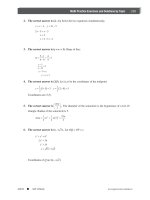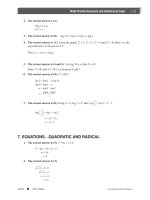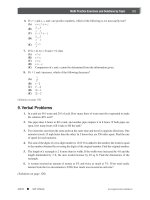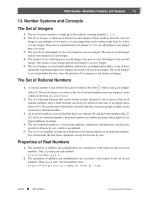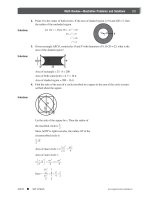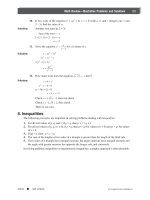SAT II History Episode 1 Part 4 doc
Bạn đang xem bản rút gọn của tài liệu. Xem và tải ngay bản đầy đủ của tài liệu tại đây (144.71 KB, 20 trang )
The Compromise of 1850 affected which of the following?
(A) California
(B) California and the Utah and New Mexico Territories
(C) Kansas and Nebraska Territories
(D) Minnesota Territory
(E) Oregon and Washington Territories
Test-Taking Strategy
Knowing at least the area of
the Louisiana Territory
would have helped you elimi-
nate at least two choices in
this question if you needed to
make an educated guess.
The correct answer is choice (B). The Compromise of 1850 affected
all the territory received from Mexico at the end of the Mexican War.
Choice (A) is only partially correct. Choice (C) and much of choice
(D) were part of the Louisiana Territory. Washington Territory was
created from part of the Oregon Territory, choice (E), after the Treaty
of 1846 fixed the border with Canada.
OREGON
TERRITORY
MINNESOTA
TERRITORY
IOWA
MO.
ILL
WIS.
INDIAN
TERRITORY
WASHINGTON
TERRITORY
CALIFORNIA
UTAH
TERRITORY
NEW MEXICO
TERRITORY
TEXAS
L.A.
ARK.
MISSOURI COMPROMISE
LINE-1820
MISS.
NEBRASKA
TERRITORY
KANSAS
TERRITORY
STRATEGIES FOR MULTIPLE-CHOICE QUESTIONS
55
Peterson’s n SAT II
Success: U.S. History www.petersons.com
ANALYSIS AND INTERPRETATION
Visuals can also be the basis of questions that ask you to analyze and
interpret data. The visuals may be cartoons, maps, charts, graphs, or
photographs. The following question asks you to analyze data and
then recall information in order to answer it.
Sales of U.S. Passenger
Cars, 1915 and 1955
(in millions)
1915 10
1920 18
1925 38
1930 27
1935 32
1940 38
1945 1
1950 60
1955 78
Based on the data in this table, one might conclude that the number of
cars sold in 1930 was a consequence of
(A) the mobilization of the automobile industry to fight
World War II
(B) a decrease in the price of steel
(C) the dumping of Japanese cars in the U.S. market
(D) the worsening economic depression in the United
States
(E) a federally regulated effort to help the auto industry
The correct answer is choice (D). First, you need to read the data and
decide what it shows—a downturn in car sales. Then you need to
look for an answer choice that gives a negative cause. If you did not
immediately connect 1930 with the depression, choice (D), you could
try educated guessing and eliminate choices. Choice (E) could be
eliminated, because it never happened and because it would have, or
should have, had a positive effect on car sales by lowering the cost.
The same two reasons eliminate choice (B). Choices (A) and (C) are
negative causes, but the United States did not enter World War II
until 1941 and dumping is a later twentieth century international
market phenomenon. Thinking about time period would have helped
you eliminate both of these answer choices.
Some questions may ask you not only to analyze information but
also to make inferences about it. Questions based on quotations are
often used to test this kind of ability.
CHAPTER 1
56
Peterson’s n SAT II
Success: U.S. Historywww.petersons.com
“The autumn of 1854 witnessed the erection of the first
log-huts byafewfamilies of New England settlers.
During the year 1855 its population increased rapidly,
chiefly by the arrival of emigrants from the Northern States.
Its log-hut existence gave way to a more advanced stage,
. . . and the growing prosperity early began to excite
the jealousy of the abettors of slavery. Viewed as the
stronghold of the Free-state party, it was made the point of
attack ”
The description above was most probably written about
(A) the settling of Missouri
(B) the settling on the frontier of Irish laborers who had
left New England mill towns
(C) the fight over the admission of Kansas as free or slave
state
(D) a settlement of New Englanders in the South
(E) a settlement of Republicans in the South
Test-Taking Strategy
Be sure to highlight the key
words in the questions in
some way—underline, circle,
bracket. Be sure you under-
stand what the question is
asking you.
This question from the Diagnostic Test is a good example of how you
can use key words as guides in analyzing and interpreting material.
There are several clues in the reading to help you determine that the
correct answer is (C) if you did not know the answer immediately:
the years 1854 and 1855, New England, emigrants from Northern
States, abettors of slavery, and Free-state party. They all point to
Kansas and the fight between the proslavery and antislavery forces
who moved into Kansas to settle it before the territory was ready to
request statehood.
RELATING IDEAS TO GIVEN DATA
According to the College Board, these questions ask you to relate
“hypotheses, concepts, principles, or generalizations to given data.”
You may be given a specific piece of information and asked for the
concept or principle it describes or vice versa. For example, you
might be asked the following:
STRATEGIES FOR MULTIPLE-CHOICE QUESTIONS
57
Peterson’s n SAT II
Success: U.S. History www.petersons.com
Which of the following was Theodore Roosevelt’s most
significant use of his “big stick” policy?
(A) The United States established a protectorate in Cuba
after the Spanish-American War.
(B) The United States sent marines to occupy Veracruz and
prevent President Huerta from receiving weapons from
Germany.
(C) Roosevelt legitimized the “big stick” policy by issuing
the Good Neighbor Policy toward Latin America.
(D) The United States supported Panamanian rebels in their
revolt against Colombia.
(E) The United States intervened in the internal affairs of
the Dominican Republic when that nation could not
repay its foreign debts.
The question stem provides the concept, Roosevelt’s “big stick”
policy, and the answer choices provide what may be examples for
you to choose an answer from. Choices (A), (D), and (E) state correct
information about Roosevelt and his foreign policy, but choice (D) is
the best answer. Choice (A) refers to the Platt Amendment, choice
(D) to the establishment of Panama, and choice (E) to a situation that
caused Roosevelt to use the Roosevelt Corollary to the Monroe
Doctrine for the first time. Of the three, the most significant effect in
the long-term history of the United States and the world was the
assigning to the United States of the right to build a canal across the
isthmus of Panama, so choice (D) is the best answer. Choice (B) is an
action of the President Wilson. Choice (C) is only partially correct.
Theodore Roosevelt legitimized the “big stick” policy through the
Roosevelt Corollary, while it was Franklin Roosevelt who adopted the
Good Neighbor Policy toward Latin America.
The question could be reversed so that the specific is presented
in the question stem and the answer choices provide concepts,
principles, or generalizations.
Theodore Roosevelt’s support of the Panamanian rebels in
their revolt against Colombia is an example of his use of
(A) the Good Neighbor Policy
(B) the Roosevelt Corollary
(C) Alliance for Progress
(D) his policy of the “big stick”
(E) Pan-Americanism
You already know that the correct answer is choice (D). Choice (A)
is a policy of Franklin Roosevelt; choice (B) is the way Theodore
CHAPTER 1
58
Peterson’s n SAT II
Success: U.S. Historywww.petersons.com
Roosevelt legitimized his “big stick” foreign policy; choice (C) refers
to Latin American policy under John F. Kennedy; and Pan-American-
ism was a policy of Secretary of State James G. Blaine under President
Benjamin Henry Harrison that resulted in the first Inter-American
Conference in 1889.
EVALUATION OF DATA
There are not many of this type of question on the test. The question
presents data and asks you to evaluate their validity for a specific
purpose. The answer choices ask you to use either internal evidence,
such as accuracy and logical consistency, to assess the information or
external criteria, such as accepted historical scholarship.
In doing research for a book about working conditions in
the textile mills in Lowell, Massachusetts, which of the
following would be most useful?
(A) A diary of a Lowell factory “girl”
(B) Newspaper accounts of the activities of the Lowell
Female Labor Reform Movement
(C) U.S. Census data from 1830 and 1840 for Lowell
(D) Account books from the Lowell textile mills
(E) A tour of one of the reconstructed mills
This question asks you to think like a historian and decide what kinds
of primary and secondary resource material you would need for your
research. Primary research is always preferable to secondary sources,
so although a tour of the mill would be interesting, it would not tell
you in the words of a Lowell “girl” what it was like to work there.
Choice (A) would give you the words of only one worker, while
choice (B) would give you the response of many women to the poor
working conditions. Choice (B) is the best answer. Choice (C) would
not address working conditions nor would choice (D).
A question that requires you to consider the consistency of
information might read like the following:
STRATEGIES FOR MULTIPLE-CHOICE QUESTIONS
59
Peterson’s n SAT II
Success: U.S. History www.petersons.com
Any discussion of the events that led to the Civil War
would have to include the
(A) Wilmot Proviso, the Missouri Compromise, and the
Tariff of Abominations
(B) Wilmot Proviso, the Compromise of 1850, and the
National Road
(C) Compromise of 1850, the Missouri Compromise, and
Fort Laramie Treaty
(D) Missouri Compromise, the Virginia Resolves, and the
Ordinance of Nullification
(E) Kentucky and Virginia Resolutions, the Tariff of
Abominations, and the Ordinance of Nullification
Test-Taking Strategy
All parts of an answer must
be correct. If part of an an-
swer is incorrect, the whole
answer is incorrect—and a
quarter-point deduction.
All the elements in choice (A) are events that added to the growing
animosity between North and South and led to the Civil War. In
choice (B), while the controversy over the National Road was an
example of sectional conflict, it was not a causal factor of the Civil
War. In choice (C), the Fort Laramie Treaty, which promised the
Native Americans $50,000 a year for 50 years in exchange for safe
passage for settlers, is incorrect. In choice (D), the Virginia Resolves
were passed before the Revolutionary War to protest Great Britain’s
policy of taxation without representation. In choice (E), the Kentucky
and Virginia Resolutions are incorrect; they were passed to protest
the Alien and Sedition Acts of 1798.
In the end, knowing the type of question you are being asked is
less important than paying attention to what the question is asking
you. Circle, underline, or bracket the key words in the question. Use
them to guide you to the correct answer.
ATTACKING THE QUESTIONS: PRACTICAL ADVICE
When you take the SAT II: U.S. History Test, you will want to have
every advantage possible. Of course, the ideal is to know the correct
answer as soon as you read the question and the answer choices, but
that does not always happen. Here are some methods to help you
score well.
1. Read the question carefully. Circle, underline, or bracket key
words and phrases. You will find words in the question prompts
such as: significant; direct result of, consequence of; true,
correct; most characteristic of, best known for, best describes;
primarily, primary reason, primary purpose; most influential;
most accurately characterizes. These are qualifiers or descriptors
that clue you to what you should be looking for in the answer
choices.
A word like significant means you should be looking for why
something is important in the larger context of U.S. history.
Words like best describes or most characteristic of are asking
CHAPTER 1
60
Peterson’s n SAT II
Success: U.S. Historywww.petersons.com
you to analyze the information and come up with an opinion
based on facts. In both instances, one or more of the answer
choices may be correct; you need to look for the one that is
most inclusive, giving the broadest view of the subject.
2. Knowing that the questions are in chronological order can help
you to eliminate answers that do not make sense for the period.
For example, identifying the Wilmot Proviso as having happened
in the first half of the nineteenth century can help you eliminate
any answers that refer to any other period.
3. Most of the questions are straightforward, but you may find some
that use qualifiers such as not/except, inconsistent, or incorrect.
For these questions, read each answer and ask yourself if it is
true about the subject of the question. If it is, cross it out, and
go to the next answer. You are looking for the choice that is not
true.
4. Be sure to use educated guessing if you know something about
the content of the question and can eliminate one or more
answer choices.
PRACTICING
Study Strategy
Check the Practice Plan for
Studying for the SAT II: U.S.
History Test, pp. 8–10.
Study Strategy
Read all the explanations.
The reasoning involved and
the additional historical
information may help you
with questions on the real
test.
Read and answer Practice Set 1 on the next page. Jot down your
answers to the questions in the margin or on a separate sheet of
paper. If you do not understand a question, you may check the
explanation immediately. You may refer to the answers question by
question, or you may wish to score the entire set at one time. Either
is acceptable.
Follow the same procedure with Practice Sets 2 and 3. You
might want to complete Practice Set 2 and correct the answers
before you try Practice Set 3. That way, you will have another chance
to work on any specific areas of weakness.
STRATEGIES FOR MULTIPLE-CHOICE QUESTIONS
61
Peterson’s n SAT II
Success: U.S. History www.petersons.com
Practice Set 1
1. The significance of the Massachusetts Bay
Company was its
(A) charter as a joint-stock company
(B) establishment of a flourishing colony
(C) transformation from a trading company
into a commonwealth
(D) limitation on the number of men who
could serve in the General Court
(E) merger with Plymouth Colony in 1691
2. The Virginia Resolves are significant because
(A) they were passed to protest the Stamp
Act
(B) they were based on the argument that
the colonies could not be taxed by
Parliament because they had no repre-
sentation in Parliament
(C) they laid the groundwork for Virginia’s
claim to western lands
(D) in passing them, the Virginia legislature
seceded from the Union
(E) in passing them, Virginia agreed to
Congressional Reconstruction
3. Elizabeth Cady Stanton is most closely
associated with which area of social reform
in the nineteenth century?
(A) abolition
(B) the temperance movement
(C) universal education
(D) women’s rights
(E) prison reform
4. The direct cause of Congress’s vote to
impeach Andrew Johnson was
(A) his opposition to Congressional Recon-
struction
(B) his opposition to the Fifteenth Amend-
ment
(C) corruption during his administration
(D) his violation of the Tenure of Office Act
(E) his veto of the Civil Rights Act of 1866
5. “I had opportunity to observe closely the
operation of two powerful forces that were
at work on the Negro’s status—the exodus
and the war. Negroes migrating to the North
in great numbers, and I observed the
anomaly of a premium being put on this
element of the population that had generally
been regarded as a burden and a handicap to
the South.”
The above was most probably written about
(A) contraband going behind the Union lines
in the Civil War
(B) movement of blacks to Northern cities
during the Vietnam War
(C) exodusters
(D) migration of African Americans in the
1890s
(E) Great Migration of 1915–1930
62
Peterson’s n SAT II
Success: U.S. Historywww.petersons.com
Explanation of Answers for
Practice Set 1
QUICK-SCORE ANSWERS
1. C 4. D
2. B 5. E
3. D
1. The correct answer is (C). The key word here is significance.
When you see this word, ask yourself what the significance is of this
event or person to the development of U.S. history. Massachusetts is
not particularly significant in terms of choices (A) and (B) because
the Virginia Company was also a joint-stock company, and for the
most part, all the English colonies flourished except for Plymouth,
which did merge with Massachusetts Bay, choice (E). But keep look-
ing because although important, choice (E) is not particularly signifi-
cant in a larger sense. That leaves choices (C) and (D). Considering
the development of the colonies, would limiting participation in
government be significant, or its opposite, insignificant? The trans-
formation of Massachusetts Bay from a trading company into a com-
monwealth made it the first self-governing political unit in what
would be the United States.
2. The correct answer is (B). The key word here is significant.
Choice (A) is true, but the meaning of the Virginia Resolves in the
larger context of U.S. history is choice (B). They established the
argument of “no taxation without representation” that became a
rallying cry for the Revolution. Choices (C), (D), and (E) are incor-
rect. You could have eliminated choices (D) and (E) by checking for
the time frame of the question. It comes after a question about
exploration and before one on the mid-nineteenth century.
Test-Taking Strategy
Read the question stem
carefully. Circle the key
words so you know clearly
what you are looking for.
3. The correct answer is (D). The key words here are most
closely. Stanton was involved in the abolition movement, choice
(A), but she is best known for organizing the Seneca Falls
women’s rights conference in 1848 and her work for women’s
suffrage. The woman most closely associated with temperance,
choice (B), is Frances Willard, who served from 1879 to 1898 as
the president of the Women’s Christian Temperance Association.
Horace Mann is considered a pioneer in the fight for universal
education, choice (C). Dorothea Dix is known for her work on
prison and asylum reform, choice (E).
63
Peterson’s n SAT II
Success: U.S. History www.petersons.com
4. The correct answer is (D). The key words are direct cause. His
enemies in Congress hated Johnson for choices (A) and (E), but
his impeachment hearings directly resulted from choice (D), his
firing of Edwin Stanton, his secretary of state. Choice (B) is
incorrect because it was the Fourteenth Amendment that he
opposed; the Fifteenth Amendment was not ratified until after his
administration. Choice (C) was not an issue in his administration,
but in that of his successor, Ullysses S. Grant.
5. The correct answer is (E). The word war is one clue, as is the
phrase “the anomaly of a premium.” The word war will help you
eliminate choice (D). Although the United States did fight the
Spanish-American War in the 1890s, the war lasted only three
months, not long enough to create an economy that would need
additional workers. The time frame of the questions in this group
will help you eliminate choice (A). Question 4 is about Andrew
Johnson’s impeachment, so an answer about the Civil War for
question 5 cannot be correct. (Contraband was the name given
to slaves who escaped behind the Union lines.) You might think
exodusters, choice (C), is correct, because the quotation uses the
word exodus, but the exodusters moved west, not north, shortly
after the Civil War. The phrase about a premium on African
Americans indicates that they were in demand; this would equate
with the need for workers in the North as the nation geared up
for World War I, choice (E). No similar movement occurred
during the Vietnam War because so many African Americans
already lived in the North, choice (B). Don’t be confused by the
Great Migration that brought some 20,000 Puritans to Massachu-
setts Bay.
EXPLANATION OF ANSWERS FOR PRACTICE SET 1
64
Peterson’s n SAT II
Success: U.S. Historywww.petersons.com
Practice Set 2
1. The British reaction to the Boston Tea Party
involved all of the following EXCEPT
(A) passage of the Massachusetts Bay
Regulating Act
(B) Edmund Burke’s warning against blaming
all Americans for the acts of some
(C) the Boston Massacre
(D) passage of the Boston Port Act
(E) suspension of the Massachusetts legisla-
ture
2. Andrew Jackson’s intention in issuing the
Specie Circular was to
(A) halt land speculation and inflation
(B) destroy the Second Bank of the United
States
(C) shift the blame for the Panic of 1837 to
Nicholas Biddle
(D) ensure that the federal government
withdrew its deposits from state banks
(E) remove government controls over
speculation and inflation
3. Plessy v. Ferguson established
(A) the scope of presidential war powers
(B) the principle of judicial review
(C) the principle of implied powers in the
Constitution
(D) Congress’s right to regulate interstate
commerce
(E) the principle of separate but equal
4. The major difference between Booker T.
Washington’s views and W.E.B. Du Bois’s
views was Du Bois’s
(A) emphasis on vocational training for
African Americans
(B) emphasis on a liberal arts education for
African Americans
(C) emphasis on the right of African Ameri-
cans to demand whatever education they
needed to gain full equality
(D) support for the Niagara Movement
(E) emphasis on continuing protests against
injustice and appeals to black pride
5. Roosevelt’s policy of “pump priming” during
the depression meant
(A) raising tariffs to protect American
manufacturers and farmers
(B) increasing the supply of goods and
lowering taxes
(C) increasing federal spending to stimulate
the economy
(D) stagflation
(E) an increase in wages annually if the
general level of prices in the economy
rose above a certain level
65
Peterson’s n SAT II
Success: U.S. History www.petersons.com
Explanation of Answers for
Practice Set 2
QUICK-SCORE ANSWERS
1. C 4. C
2. A 5. C
3. E
Review Strategy
This is a not/except question.
Ask yourself if each answer
is a correct response to the
question. If it is, cross it out
and go on to the next
answer.
1. The correct answer is (C). If you did not remember that the
Boston Massacre preceded the Tea Party, you could try eliminat-
ing answers. The British reacted to the Tea Party by passing the
Coercive Acts, which the colonists called the Intolerable Acts.
Choice (A), also known as the Massachusetts Government Act,
and choices (D) and (E) are elements of those laws. The Boston
Tea Party caused even some of the colonists’ supporters in
Parliament to speak out against the colonists, but in so doing,
Edmund Burke also warned his fellow Englishmen about the
dangers ahead if they pursued war with the colonies, choice (B).
2. The correct answer is (A). All these answers have some
information that is relevant to Andrew Jackson’s terms in office,
so you need to read each one carefully. Jackson did set out to
destroy the Second Bank, choice (B), of which Nicholas Biddle
was president, first by vetoing the renewal of its charter and
then by removing federal deposits from it. There was a Panic of
1837, but Martin Van Buren was president by then, choice (C).
Jackson had the federal government withdraw its money not
from state banks but from the national bank, choice (D); he then
had the money deposited in state banks, known as “pet banks.”
Jackson’s intent in destroying the Second Bank was to make the
federal government less powerful. He unwittingly accomplished
choice (E) and set the groundwork for the Panic of 1837. His
intention, however, had been to halt land speculation and
inflation, choice (A), by requiring that public land be paid for in
gold or silver.
3. The correct answer is (E). You may think that choice (A)
refers to the Presidential War Powers Act of 1973, but this is law,
not a Supreme Court decision. Marbury v. Madison established
choice (B). McCulloch v. Maryland established choice (C).
Congress’s right to regulate interstate commerce was set forth in
Gibbons v. Ogden.
66
Peterson’s n SAT II
Success: U.S. Historywww.petersons.com
Test-Taking Strategy
Read the question stems
carefully and underline or
circle key words so you
know clearly what you are
looking for.
4. The correct answer is (C). The question asks for the major
difference between Washington and Du Bois, so you need to
look for the most inclusive correct answer. Choice (A) is
incorrect because that was Washington’s position. Choices (B),
(C), (D), and (E) are all things that Du Bois supported in contrast
to Washington, but choices (B) and (E) are elements of choice
(C), so choice (C) is the best choice.
5. The correct answer is (C). The objective of deficit spending is
to create jobs. With greater employment, workers will have more
money to spend. This stimulates demand, thus increasing
production that creates even more jobs. It was the theory behind
Roosevelt’s economic policy of “priming the pump.” Many
Democratic presidents since Roosevelt have followed it. Choice
(B) is the definition of supply-side economics, the theory behind
Ronald Reagan’s economic policy; it states that by giving people
more money, they will increase their savings and their purchas-
ing power, thereby generating more economic activity. Stagfla-
tion, choice (D), is a condition of the economy in which inflation
combines with low economic activity; it was the prevailing
economic condition of the 1970s. Choice (E) is the definition of
cost-of-living adjustment, which is also found in some govern-
ment programs, such as Social Security. Choice (A) is a definition
of the policy known as protectionism.
STRATEGIES FOR MULTIPLE-CHOICE QUESTIONS
67
Peterson’s n SAT II
Success: U.S. History www.petersons.com
Practice Set 3
1. The Virginia and Kentucky Resolutions rest on
the argument that the judge of the constitu-
tionality of a law passed by Congress is
(A) the Supreme Court
(B) Congress
(C) state legislatures
(D) popular sovereignty
(E) presidential veto
2. The “Solid South” came apart in the
election of
(A) 1912
(B) 1920
(C) 1928
(D) 1932
(E) 1936
Questions 3–5 refer to the following map.
3. According to the map, which two Northeast
states were the only states to lose population
between 1970 and 1980?
(A) New York and Pennsylvania
(B) Massachusetts and Rhode Island
(C) New York and Rhode Island
(D) Pennsylvania and Rhode Island
(E) Massachusetts and Pennsylvania
4. Which region of the 48 contiguous states had
the greatest percentage increase in popula-
tion between 1970 and 1980?
(A) New England
(B) Mid-Atlantic
(C) Midwest
(D) Southeast
(E) Southwest
5. Which of the following states experienced
the greatest percentage increase in popula-
tion between 1970 and 1980?
(A) New Hampshire
(B) Florida
(C) Nevada
(D) Arizona
(E) Texas
FL
+41.1
NM
+27.4
DE
+8.5
MD
+7.0
TX
+26.6
OK
+17.3
KS
+4.6
NE
+5.4
SD
+3.3
MT
+12.9
WY
+41.1
CO
+30.4
UT
+37.7
ID
+32.3
AZ
+53.2
NV
+63.8
WA
+20.6
CA
+17.6
OR
+25.2
KY
+13.1
ME
+13.1
NY
-4.0
PA
+0.2
MI
+4.0
VT
+15.0
NH
+24.6
MA
+0.7
RI
-4.0
CT
+2.1
VA
+14.4
WV
+10.7
IN
+5.1
IL
+2.2
NC
+15.0
TN
+15.8
SC
+18.5
AL
+12.4
MS
+13.3
AR
+18.8
LA
+15.2
MO
+4.9
IA
+5.1
MN
+6.9
WI
+6.3
NJ
+2.4
GA
+17.8
ND
+5.6
OH
+1.1
68
Peterson’s n SAT II
Success: U.S. Historywww.petersons.com
Explanation of Answers for
Practice Set 3
QUICK-SCORE ANSWERS
1. C 4. E
2. C 5. C
3. C
Test-Taking Strategy
Thinking about the time
frame of a question can help
you sort through the answer
choices when you are not
sure of the correct answer.
1. The correct answer is (C). Logic tips the scale toward choice
(C) as the answer because these are state resolutions. Because
the question is about the period of the early republic and these
are Southern states, they would be trying to further states’ rights
and not the power of the president or of the Supreme Court.
Therefore, logic indicates that choices (A) and (E) are incorrect.
Popular sovereignty, choice (D), is a later development of the
nineteenth century to solve the slavery question. Choice (B) does
not make sense.
2. The correct answer is (C). The “Solid South” is a term used to
refer to Southern politics after Reconstruction. In an effort to rid
themselves of the Republican governments that were imposed
during Radical Reconstruction, most Southern men joined the
Democratic Party. In 1928, Herbert Hoover was able to break
this Democratic hold over the South in his defeat of Al Smith.
Although Smith lost the rural and small-town Southern vote, he
attracted to the Democratic Party city dwellers, Catholics,
immigrants, and the working class.
3. The correct answer is (C). Questions 3, 4, and 5 are straight-
forward questions that ask you to read the map and choose the
correct answer based on what you see.
4. The correct answer is (E).
5. The correct answer is (C).
69
Peterson’s n SAT II
Success: U.S. History www.petersons.com
Chapter 2
REVIEWING THE COLONIAL PERIOD
TO 1789
The following review of Native American peoples, European explora-
tion and colonization, the expansion of the thirteen original English
colonies, the movement toward independence, and the beginning of
the new nation highlights key events and people. According to the
College Board, approximately 20 percent of the SAT II: U.S. History
Test is drawn from this period.
SECTION 1. DISCOVERY, SETTLEMENT, AND
EXPANSION TO 1754
Review Strategy
See page 80 for the origins of
slavery in the Americas.
The study of U.S. history is the study of the intertwining of many
different strands of historical development. A point at which to begin
is Europe in the sixteenth century. The rise of nation-states, religious
upheavals, and economic developments led Europeans to seek riches,
territories, and dominion outside Europe to bolster their power on
the continent. In studying U.S. history, it is important to understand
how and why these events interacted to create European colonies in
the Americas. It is also possible to see in this early period the
foundations of later developments in U.S. history: not only political
developments, such as the beginnings of representative government,
but also social and cultural developments such as the subjugation of
Native Americans and the institutionalization of slavery.
FAST FACTS
The First Americans
• Experts estimate that when Columbus reached the Americas, some
1 to 2 million Native Americans lived north of Mexico in eight
major culture areas in what is now the United States and Canada:
Subarctic, Northwest Coast, California, Great Basin and Plateau,
Plains, Southwest, Northeast Woodlands, and Southeast. Another 20
million lived in Mexico, and 30 million lived in South America. The
First Americans probably came across a land bridge now covered
by the Bering Strait some 15,000 to 30,000 years ago.
• Some 12,000 years ago, as the Ice Age animals began to disappear,
people turned to hunting smaller game, fishing, and gathering
70
Peterson’s n SAT II
Success: U.S. Historywww.petersons.com
NATIVE AMERICANS OF THE UNITED STATES
CULTURE REGION
GENERAL
GEOGRAPHICAL AREA
GENERAL CULTURAL
CHARACTERISTICS
REPRESENTATIVE
PEOPLES
Subarctic Interior of present
Alaska and Canada
Fishing and hunting Tanama, Ingalik,
Ahtena
Northwest Coast Coastal plain from
present California-
Oregon border to about
the current Canada-
Alaska border
Fishing and hunting sea animals;
some hunting of small game on
land and food gathering; potlatch
ceremony to display wealth
Tlingit, Chinook,
Tillamook
California Present state of
California
Food gathering, especially acorns,
and hunting and fishing; arts and
crafts such as baskets
Pomo, Chumash,
Yana
Great Basin and
Plateau
Intermountain Basins
and Plateaus in present
states of Washington,
Oregon, Idaho, Nevada,
Utah, Colorado,
Wyoming, Montana
Basin culture: Nomadic hunters
and gathers moving in small bands
of extended families; influence of
Plains’ peoples seen in adoption of
the horse and buffalo hunting
Plateau culture: Originally
nomadic fishers and small game
hunters and gatherers; influence of
Plains’ peoples seen as groups
begin hunting buffalo on
horseback
Shoshone, Nez
Perce, Cheyenne
Plains Center of the United
States
Originally farmers and hunters; by
1700 almost every Plains nation
has horses; begin to hunt buffalo
on horseback; develop culture
traits that Americans come to
think of as “Indian,” such as tipis
Kiowa, Pawnee,
Sioux
Southwest Present Southwestern
United States and parts
of Southeastern
California, Western
Texas, Southern Nevada,
Utah, and Colorado
Early sedentary farming cultures:
Mogollon, Hohokam, Anasazi (cliff
dwellers); later peoples called
Pueblos by the Spanish because
they live in small villages; weavers,
basket makers, and potters
Apache, Pima, Zuni
REVIEWING THE COLONIAL PERIOD TO 1789
71
Peterson’s n SAT II
Success: U.S. History www.petersons.com
NATIVE AMERICANS OF THE UNITED STATES
CULTURE REGION
GENERAL
GEOGRAPHICAL AREA
GENERAL CULTURAL
CHARACTERISTICS
REPRESENTATIVE
PEOPLES
Northeast
Woodlands
From the Mississippi east
to the Atlantic Ocean
and as far south as South
Carolina, Tennessee, and
Arkansas
Early peoples known as Mound
Builders: Adena, Hopewell;
sedentary farmers who build large
ceremonial mounds; evidence of a
class system and some hierarchical
government; trading network; arts
and crafts for trade
Also hunters and farmers; villages,
some fortified; governed by village
councils
Iroquois, Shawnee,
Sauk
Southeast Below the Northeast
Woodlands to the Gulf
of Mexico and into East
Texas
Mound-building culture,
Mississippian, also in Northeastern
Woodlands; lasts into the 1600s
among Cherokee, Natchez, and a
few other peoples; well-developed
hierarchical organization with
priests as the head of government,
warrior class, traders, farmers,
artisans, and slaves
Creek, Choctaw,
Yamasee
plants. About 5,000 years ago, some peoples began to domesticate
plants. With a stable food supply, groups established permanent
settlements, and the population increased. Specialization in arts and
crafts resulted, and hierarchical organizations grew up, often
combining religious and secular power and a social structure. In
some areas, monumental buildings were erected. The Native
Americans who met the Europeans in the 1400s and 1500s had a
wide range of cultures, dependent for the most part on the
environment.
• There was a great diversity among Native Americans. Not only did
they provide for their food in different ways, but their artifacts, those
things they made for their own use and for trade, were vastly different
depending on where they lived. For example, Plains Native Americans
who moved in pursuit of food carried their goods in leather bags,
while sedentary farmers like the Pueblo peoples wove baskets and
made pottery. It is generally thought that there were 200 different lan-
guages spoken by Native Americans north of Mexico.
European Voyages of Exploration
• Several factors spurred European interest in exploration. (1) The
Crusades of the eleventh and twelfth centuries had interested
Europeans in trade with Asia for luxury goods, such as spices,
CHAPTER 2
72
Peterson’s n SAT II
Success: U.S. Historywww.petersons.com
KEY EXPLORERS AND THEIR ACHIEVEMENTS
DATE EXPLORER COUNTRY ACHIEVEMENT
1487–1488 Diaz Portugal Sails around southern tip of Africa
1492–1504 Columbus Spain First European to explore the Western
Hemisphere; explores the West Indies and
the Caribbean
1497–1498 da Gama Portugal Sails around Africa to India
1497–1501(?) Cabot England Explores Newfoundland and Nova Scotia
1499 Vespucci Spain Explores coast of South America
1500 Cabral Portugal Explores Brazil
1508–1509
1513
Ponce de Leon Spain Explores Puerto Rico
Explores Florida
1516–1520 de Soto Spain Explores Central America
1519 Magellan Spain Circumnavigates the globe
1519 Cortés Spain Explores Mexico; conquers the Aztecs
1524 Verrazano France Explores northeastern coast of North
America
1531 Pizarro Spain Explores Peru; conquers the Incas
1534–1542 Cartier France Explores St. Lawrence River
1539–1542 de Soto Spain Explores lower Mississippi River
1540–1542 Coronado Spain Explores southwestern U.S.
1542–1543 Cabrillo Spain Explores western coast of North America
1603–1615 Champlain France Explores St. Lawrence River valley
Founds Quebec
1609 Hudson Netherlands Explores east coast of North America,
including Hudson River
1610–1611 Hudson England Explores Hudson Bay
1673 Marquette/Joliet France Explores Mississippi River
1679–1682 La Salle France Explores Great Lakes region; reaches mouth
of the Mississippi River
sugar, and silk. (2) European merchants, especially in trading cities
such as Genoa and Venice, and the Hanseatic League, a confedera-
tion of cities on the North and Baltic Seas, wanted new trade
routes to Asia to cut out Middle Eastern middlemen. (3) Techno-
logical advances, such as the astrolabe and compass, made it
REVIEWING THE COLONIAL PERIOD TO 1789
73
Peterson’s n SAT II
Success: U.S. History www.petersons.com
possible for sailors to try new and dangerous water routes. (4) The
rise of nation-states encouraged economic development and also
rivalry among European nations for new territories and new wealth.
(5) The Renaissance engendered a sense of curiosity and adven-
ture among Europeans.
First Spanish Settlements
• Spanish settlement in the Americas began in the Caribbean, moved
north into what is now the United States, and moved west and
south into Central and South America. Between 1492 and 1800,
Spain had conquered and colonized large sections of Central and
South America and set up settlements in what are today California,
New Mexico, Arizona, Texas, Mississippi, Louisiana, and Florida.
• The oldest permanent European settlement in the United States is
St. Augustine, Florida. Settlements often began as a mission or a
mission and presidio, a fort, with towns being established at a
later stage of development. New Spain was divided into viceroyal-
ties and governed by viceroys appointed by the monarch.
Test-Taking Strategy
Items 4 and 5 illustrate the
Columbian Exchange.
• Long-term Spanish influences include (1) the use of Spanish as the
dominant language in Central and South America; (2) the introduc-
tion of Roman Catholicism to Native Americans; (3) the subjugation
and killing of Native Americans and taking of their lands and
wealth; (4) introduction of European crops, livestock, iron prod-
ucts, and firearms into native cultures; and (5) the introduction of
Native American crops into Europe.
French Policy
• The French did not begin attempts at colonization until the early
1600s. In 1608, Samuel de Champlain founded Quebec in what
is today Canada, but its northern climate attracted few colonists. By
1680, the French had established a line of settlements from Canada
and the Great Lakes to the Gulf of Mexico.
• Unlike the Spanish, the French had not found gold but had found
an abundant source of furs for export. Only some 10,000 settlers
had come to New France by 1680 because (1) the mainland
settlements were not so rich as the sugar island colonies of the
French, (2) most French monarchs were more interested in
securing their power in Europe than in establishing American
colonies, and (3) Huguenots, religious dissidents, were not
allowed to emigrate.
Test-Taking Strategy
Keep in mind the last
sentence and be sure to
identify those later conse-
quences.
• Government was by a council appointed by the king, similar to the
government of New Spain. In 1608, the French, under Champlain,
had joined the Algonquins and Hurons in a fight against the
Iroquois. The hatred of the French that this battle aroused among
the Iroquois had significant consequences for later British colonists.
CHAPTER 2
74
Peterson’s n SAT II
Success: U.S. Historywww.petersons.com
